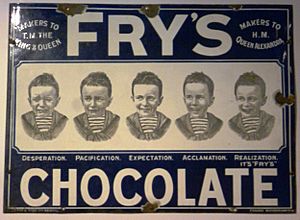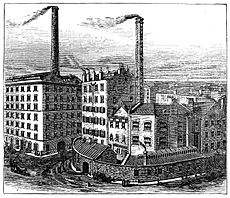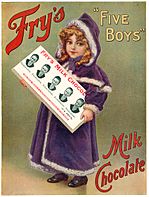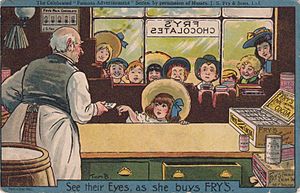- This page was last modified on 17 October 2025, at 10:18. Suggest an edit.
J. S. Fry & Sons facts for kids

The Somerdale Factory in 2010
|
|
|
Formerly
|
|
|---|---|
| Private (1761–1919) | |
| Industry | Confectionery |
| Fate | Merged with Cadbury Brothers in 1919. Loss of operational independence in 1967. Original factory closed 2011. |
| Founded | 1761 in Bristol |
| Founder | Joseph Fry |
| Defunct | 2010 |
| Headquarters | , |
|
Key people
|
Joseph Storrs Fry II |
| Products | Chocolate |
| Brands | |
| Parent | Cadbury (1919–2010) |
J. S. Fry & Sons, often called Fry's, was a famous British chocolate company. It was started by Joseph Storrs Fry and his family. The company began in Bristol, England, in the 1700s.
In 1847, Fry's made the very first solid chocolate bar. They also created the first chocolate with a filling, called Cream Sticks, in 1853. Fry's is best known for two popular treats: Fry's Chocolate Cream, which was the first chocolate bar made for everyone to buy in 1866, and Fry's Turkish Delight, which came out in 1914.
Fry's was one of the three biggest chocolate makers in Britain for a long time, along with Cadbury and Rowntree's. All three companies were started by people called Quakers. Fry's later became part of Cadbury. Their factory near Bristol, called the Somerdale Factory, closed in 2011 after Kraft Foods Inc. took over Cadbury's.
Contents
The Story of Fry's Chocolate
How Fry's Chocolate Began
Joseph Fry was a Quaker born in 1728. He started making chocolate around 1759. In 1761, Joseph Fry and John Vaughan bought a small shop. They also got a special way to make chocolate better. Their company was first called "Fry, Vaughan & Co."
In 1777, their chocolate factory moved to Union Street in Bristol. When Joseph Fry passed away in 1787, the company's name changed to "Anna Fry & Son." In 1795, Joseph Storrs Fry took over the business. He invented a new way to grind cocoa beans using a Watt steam engine. This meant they could make chocolate much faster in a factory.
(Left): An advertisement from around 1910; (right): An advertisement for Fry's pure breakfast cocoa from The Strand Magazine, September 1917.
Growing the Chocolate Business
In 1803, Anna Fry died. Joseph Storrs Fry then worked with a Dr. Hunt, and the company became "Fry & Hunt." In 1822, Dr. Hunt left, and Joseph Storrs Fry brought his sons, Joseph, Francis, and Richard, into the business. The company was then named "J. S. Fry & Sons." It quickly became the biggest chocolate maker in the UK.
In 1835, Joseph Storrs Fry died, and his sons took full control of the company.
Famous Fry's Products
In 1847, the Fry's factory in Bristol made a chocolate bar that could be produced in large amounts. This was a big step for chocolate! In 1866, they started making the Fry's Chocolate Cream bar.
Over the next few decades, Fry's created more than 220 different products. This included the UK's first chocolate Easter egg in 1873. They also launched Fry's Turkish Delight in 1914. By 1896, the Fry family still ran the company, with Joseph Storrs Fry II as the chairman. He was the grandson of the first Joseph Storrs Fry.
Changes and Mergers
Near the start of World War I, Fry's was one of the largest employers in Bristol. Joseph Storrs Fry II died in 1913. In 1919, Fry's joined with Cadbury's chocolate. The new combined company was called "British Cocoa and Chocolate Company."
From 1923, the Fry's part of the company began to move to the Somerdale Factory in Keynsham, just outside Bristol. After 1981, the name Fry's was no longer used at the Somerdale factory. However, the factory still made many Cadbury's products.
In October 2007, Cadbury announced plans to close the Somerdale factory by 2010. This meant about 500 jobs would be lost. The company wanted to move production to a new factory in Poland to stay competitive. The land where the factory stood was also very valuable. Many people were sad about the closure.
In February 2010, Kraft Foods Inc. took over Cadbury plc. During the takeover, Kraft had promised to keep the Somerdale factory open. However, they later confirmed it would close in 2011. This caused a lot of upset and was even looked into by a special committee in the UK Parliament.
Fry's in Pop Culture

Advertisement with the distinctive "five boys" design, displayed in the Kirkcaldy Museum and Art Gallery
On the TV show Being Human, an old Fry's Cocoa billboard is seen on the side of the main characters' house. This was a small tribute to the show's original setting in Bristol.
In April 2020, an old advertising sign for Fry's was shown on the BBC show Antiques Roadshow. It featured the famous "five boys" design and was valued at £1,000-£1,500. The boy in the picture, Lindsay Poulton, was photographed in 1886 by his father. For the first picture, his father made him cry by putting a cloth soaked in ammonia around his neck. Years later, when he was in his eighties, Poulton told this story to Fry's employees during a factory tour.
The "five boys" design showed different feelings: "Desperation, Pacification, Expectation, Acclamation and Realization 'It's Fry's'." The sign also mentioned Queen Alexandra, which means it was made before she died in 1925.
Images for kids
See also
 In Spanish: J. S. Fry & Sons para niños
In Spanish: J. S. Fry & Sons para niños







